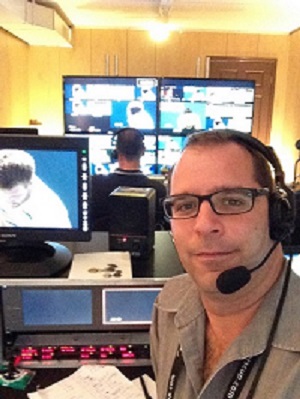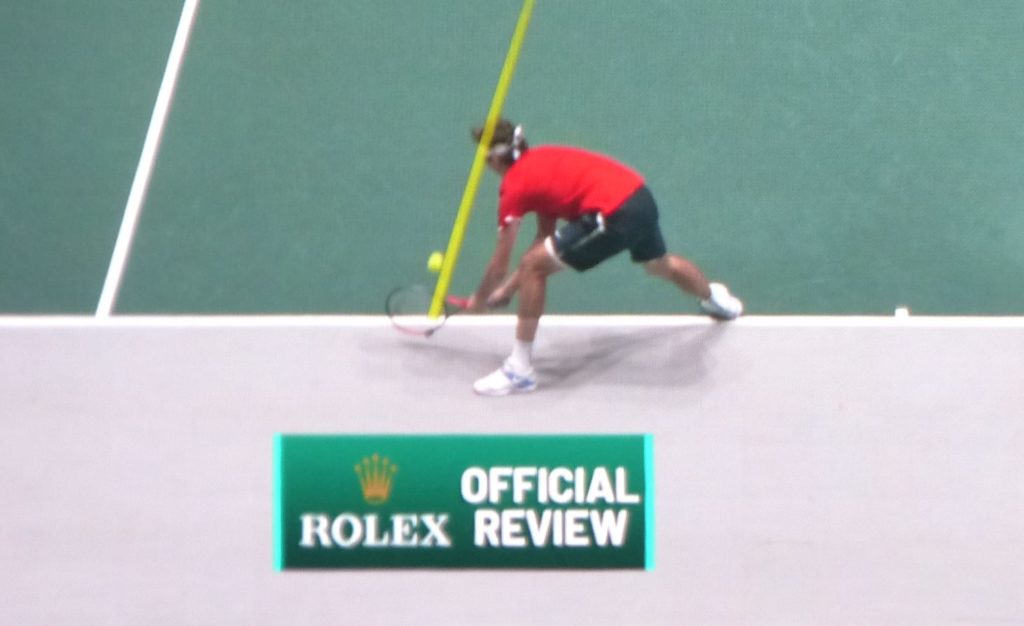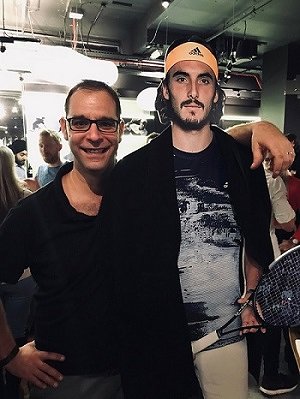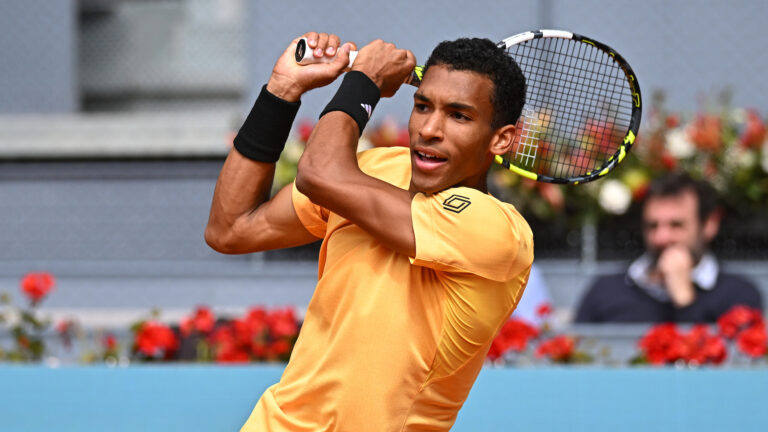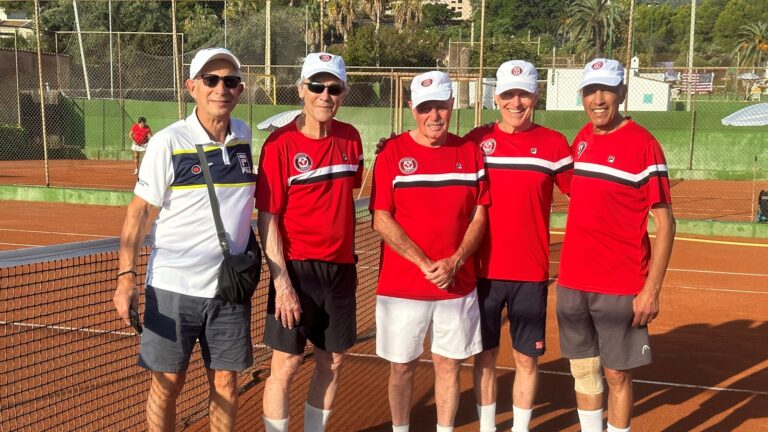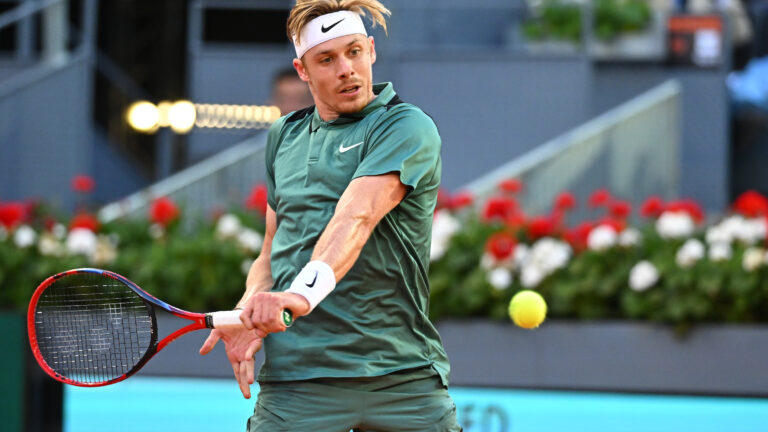
|||Photo by: TennisTV.com||Photo by: TennisTV.com
Stéphane Trudel is a graphics operator and statistician born, raised and living in Montreal, who covers ATP Masters 1000 Series tournaments for the technology firm Deltatre, which is under contract to ATP Media.
A graduate of Ryerson Polytechnical Institute (now Ryerson University) in Toronto, Trudel got an internship shooting video at the 1996 Canadian Open (then the duMaurier Open) in Toronto as an unpaid ENG hand-held cameraman for Tennis Canada. He also worked the Montreal tournament that summer and fondly recalls eventually being rewarded for his long hours and tireless efforts with a cheque for $867.11.
He continued working the events each summer and in 2000 got an offer from the American company IDS, which did statistics, radar gun, scoreboard services etc. for the tournaments. They wanted to hire him not as a cameraman but doing graphics and statistics. When he was told he would be working all over the world, his reply was a simple, “sure why not?” Time passes, now 20 years later he’s still in the business doing graphics/statistics at the highest levels of international tennis events.
Here’s our conversation:
WHAT ARE ALL THE THINGS YOU KEEP TRACK OF DOING STATS, AND CAN YOU DO THOSE BY YOURSELF?
ST: Doing the TV graphics, there’s a statistician who sits beside me and he or she is in charge of inputting the data – obviously I keep an eye on it. I watch every point that’s played. When we do statistics, we answer five questions about every point: The first one being the serve – is it in or out? The second one is who won the point – player A or player B? The third is how the point was won – was it a winner or an error and, if it was an error, was it forced or unforced? The fourth question is who was the last person who touched the ball and whether it was his forehand or backhand? The fifth and final question is the positioning of the players on the court. So were they both at the back of the court, was one at the net, was it a drop shot? – things like that.
That’s what we look for point by point. Then during the match I can look for some trends – for example I see that combined both servers have won 19 consecutive points, something like that. That’s information I can give to the commentators. The commentators are watching the match and they give their own statistics, but I have a different eye and can give them a bit more additional information.
NOW YOU HAVE THIS PERSON BESIDE YOU DOING THE STATS AND YOU SORT OF CO-ORDINATE EVERYTING. WHEN YOU STARTED OUT DID YOU HAVE THAT OR WAS IT JUST YOU BY YOURSELF?
ST: Then it was just me by myself – back then we would actually do the stats courtside but now we do it in the truck. We’d be courtside so if you look at the early footage in 2001 of the Masters Series, you can see me or another statistician who’s courtside in a prime box. That was fun to be courtside.
WAS IT BETTER TO BE COURTSIDE OR TO DO IT OFF A MONITOR?
ST: When you’re courtside you get a better feel of the pace of the ball – when you’re on a monitor it’s a little bit more difficult. But being in the truck is a more controlled environment. All and all I think being in the truck is quite advantageous.
HOW HAS DOING STATS CHANGED, MAYBE TECHNICAL IMPROVEMENTS, SINCE YOU FIRST STARTED?
ST: (Trudel here in his workplace) It hasn’t changed that much. I think we’ve gotten more consistent with our stats because the people who do the stats for us are very passionate about the sport and they come back year after year. For example the three statisticians who work for us in Rome have been doing it for 15 years. And they’re people that have regular full-time jobs who take a week off, or a vacation, to come and work with us because they love it. You have to love it because the days are pretty long – you know when tennis starts but you never know when it finishes. When you have five or six matches a day and get five or six matches that are three sets, you can finish at one or two or even three o’clock in the morning.
SO EVERY PLACE YOU GO YOU GET LOCALS WHO DO THE STATS?
ST: Yes. We obviously give them training for a few days. Then it’s the same people that come every year (at the nine Masters 1000 events and the ATP Finals in London).
JUDGMENTS LIKE WINNERS AND UNFORCED ERRORS, HOW HARD ARE THEY TO MAKE?
ST: The winners are pretty straight forward – it’s obviously when the opponent doesn’t touch the ball with the racquet. For the forced and unforced errors – that’s subjective so you have 10 people that will sit at a tennis match and you’ll have 10 sets of different numbers that will be fairly similar. We have the first level of statistics which are accurate – aces, double faults, first-serve percentage, first-serve points won, second-serve points won etc. Regardless of who’s watching the match, those numbers will be identical. Then the second level of stats is winners, unforced errors, points won at the net etc. So you’ll have a discrepancy sometimes because it’s a human judgment – but we have set criteria as to what we consider a forced or an unforced error. The statisticians and myself, we all play tennis – not at a very good level but we play – so we understand what’s required to complete a point or play a match. For example, the longer the rally, we’ll be more lenient as to unforced or forced errors.
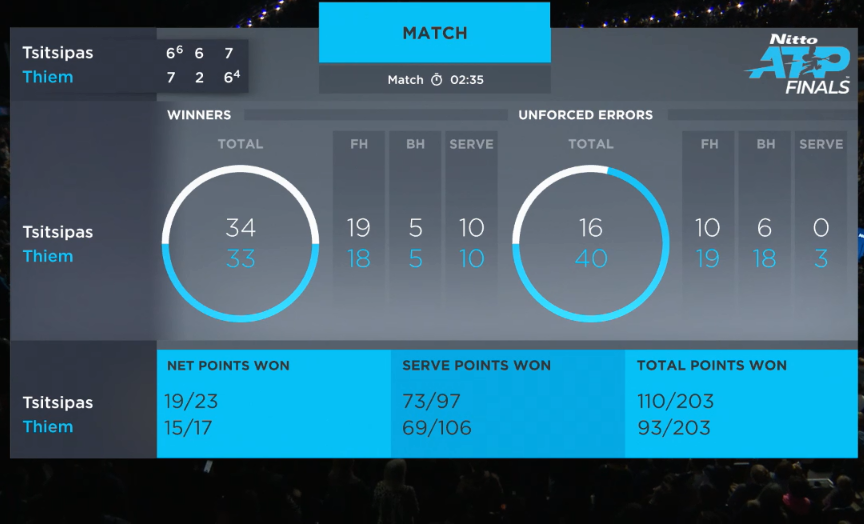
HOW DO YOU DETERMINE WHAT’S A SERVICE WINNER?
ST: If you serve and the returner gets a racquet on it, hits the ball and it dribbles toward the net, for us that’s a forced return error. We consider a service winner when the serve is in and the player touches it with his racquet but the ball keeps going backwards or flies into the crowd, where he has no control over the return. But if he does get a racquet on it and the ball goes forward, that’s a forehand or backhand forced error.
A LOT OF TOURNAMENTS DON’T LIST SERVICE WINNERS ON THE MAIN STATS PAGES.
ST: If you look at the set or match stats – we do three pages of stats and page two is the Hawk-Eye stats. On page one you’ll see winners or errors – forehand, backhand and serve. For example, you have 18 serve winners but when you get to the third page the aces will be 10. So that means there were 10 aces and the other eight were service winners.
HOW HARD DO YOU HAVE TO CONCENTRATE DURING A MATCH?
ST: Every point that gets played you analyze, you concentrate. Every point that’s played you’re watching it and dissecting it. Tennis can last pretty long, for example when I went to Paris-Bercy and it’s six matches a day. Matches start at 11 a.m. and I do every single one, although we have breaks to go to the bathroom and eat. In between matches there’s eight to 10 minutes. We have very qualified supervisors that do all the positions. They can fill in and do the graphics and stats.
WHAT’S THE BIGGEST MISTAKE YOU’VE EVER MADE?
ST: The one I remember the most was a way back in 2002, in Monte Carlo during the final. It was between (Juan Carlos) Ferrero and (Carlos) Moya. Juan Carlos won the final and at the end of the match during the speeches, you graphic the player…so ‘Juan Carlos Ferrero 2002 Monte Carlo Champion.’ But I made a mistake – I had prepared a graphic and put ‘Carlos Moya 2002 Monte Carlo Champion.’ He was the runner-up. And it got on screen for a little while. I wasn’t very proud of that moment. But I learn from my mistakes. Everybody makes mistakes. What I was told when I got started in this business – and it stays with me to this day – is it’s human to make mistakes but learn from your mistakes, and only make that mistake once.
Since then I’ve never put the champion’s graphic on the wrong person. But it was pretty embarrassing.
WHAT DO YOU THINK IS THE MOST IMPORTANT STAT IN DETERMINING WHO WINS AND WHO LOSES? IS THERE ONE YOU THINK IS MOST CRUCIAL?
ST: The key really is the importance of the point – when you win that point. I’ve seen matches where a player has 50 winners and 30 unforced errors but he’ll lose the match because his break points were zero for four. So the most crucial stat, regardless of anything else, is the break points converted. You can serve for 83 per cent and win 92 per cent of your points on first serve – but if you’re zero for four on break points, it’s tough to win unless you go to the tiebreak and it’s 7-6, 7-6.
After that, there’s points won on the second serve. The saying is ‘you’re only as good as your second serve’ – so you’ve got to defend that second serve. But obviously break points is the key one.
HOW HAVE YOU IMPROVED FROM WHEN YOU FIRST STARTED?
ST: I think I’ve improved because I really enjoy the game more and I’m more into it. By starting to play when I first started working in tennis, I learned to appreciate the difficulties of certain shots. And then starting to do more research, historical research about players, that’s helped. And also being surrounded by other like-minded people who love the sport. You always get better whether you play sports or you’re learning a language or whatever when you’re with somebody that’s got a higher level than you. So I’m lucky to be around people who are very passionate.

YOU’RE GOOD AT GETTING SOME PRETTY OBSCURE STATS – COMING UP WITH AN ANGLE NOBODY ELSE HAS THOUGHT OF. WHAT GOES THROUGH YOUR MIND?
ST: The North American culture is very stats heavy, so being North American, being Canadian, I’ve always been surrounded by stats – American football stats, hockey stats. A situation arises and I just start asking questions. Sometimes they’re very detailed and a little bit obscure. For example about Federer’s first-serve percentage in 2019 – when his first-serve percentage was 68% or higher, he had 18 wins and three losses. Those three losses were all to Dominic Thiem – Indian Wells final 70%, Madrid quarter-final 72% and London ATP Finals 69%.
When the match starts and you get into the flow and feel – that’s when more of the ideas start popping up. After having done this for a while, you kind of have certain stats that you look for.
DO YOU GET ANY FEEDBACK FROM PLAYERS ON THE STATS?
ST: No, not really – we don’t really interact with the players. But I do have a story from when I first started in 2001. You remember Marat Safin, the big Russian – he had come to see us, not me directly but our group, and he was asking questions about his first serve because he was bombing it at 230 km/hr but his first serve points won weren’t the best. So he was asking ‘what can I do?’ Then we talked to him about serve placement – so what Marat did was end up taking a bit of pace off his first serve. He went from 230 km/hr to about 210km/hr. But he was placing it a bit better – more into the corners and his first serve points improved a lot. But that’s the only time I know of a player coming to us.
YOU ALSO WORK AT ROLAND GARROS. WHAT’S THAT LIKE AND HOW IS IT DIFFERENT FOR YOU?
ST: At the French Open I work with Hawk-Eye. Although it’s not official on clay, Hawk-Eye does serve analysis for television. France Television is the local broadcaster and I work for Hawk-Eye for them because my first language is French so I’m able to communicate with them.
It’s quite interesting – I’ve been able to get on air. If you’re at the French Open and you watch the French television coverage and hear a Québécois voice – it’s mine. It all started when I would give information to the main commentator – Lionel Chamoulaud, who’s now retired. I’d give him stats in the ear and he’d repeat it on air. One day, there as a big rain delay and he came to find me and said ‘I’m going to find production and see if they can bring a microphone to your work area. You give me the stats and I’m just repeating them. You’re actually living them and you know what you’re talking about.’ So the next day a technician brought me a microphone and when I’d have a stat I’d tell the commentator in his ear. So then he would say something like ‘Rafael Nadal has a great record when he plays a Frenchman, and a particularly great record against one specific player. Here’s our friend Stéphane to give us more details’ and I would say something like, ‘thanks Lionel, Rafael Nadal has a 91-13 record against French opposition and his favorite opponent is Richard Gasquet. Rafa is 16-0 against Richard and he’s even won the last 28 consecutive sets the two have played. The last time the Frenchman won a set was in the 2008 quarter-finals in Toronto – 14-12 in the first set tiebreak!’
WHAT’S YOUR RELATIONSHIP WITH HAWK-EYE ON YOUR JOB?
ST: We communicate with each other during matches. I have Hawk-Eye data that I have available and they’re looking at that data. Sometimes they’ll say ‘keep an eye on this.’ And I’ll put that out on the ScoreBug (graphic in lower left corner of screen), because that’s where the stats come out. That’s how we interact, or during matches we can communicate and say what to look out for. Sometimes, for example, there’ll be a serve and we’re not too sure if it’s an ace or a service winner, so I can call them and ask ‘did you guys log that as an ace?’ They log their stuff as well.
WHAT HAPPENS IF IT’S CALLED AN ACE AND THEY SEE IT WAS ACTUALLY OUT?
ST: We go with the umpire’s call, that’s the official decision.
HOW MUCH CHEERING DO YOU DO DURING A MATCH? IF IT’S THREE IN THE MORNING – YOU’RE OBVIOUSLY CHEERING FOR ONE GUY TO FINISH THE MATCH?
ST: (Trudel here with a Stefanos Tsitsipas cut-out) Our golden rule is whoever wins the first set better win the second set. We normally end up cheering for the person who won the first set. The days are long – the matches are quite long. We have our favourites – but we don’t want to get home too late. But who I root for will not influence the outcome of the match.
Ultimately, if I get a good interesting match, and it goes three sets, that’s what I like. I love matches that go into the third and it’s 5-all, and you feel the pressure and the tense moments. Those are great.
WHAT DO YOU NOTICE IN STATS FROM OTHER SPORTS?
ST: I don’t watch baseball a lot, but I saw the movie Moneyball, which was really interesting about how they took players and looked at their numbers and that’s how they formed a team. The hockey stats are pretty straight-forward but sometimes I’ll get some ideas. For example on twitter I follow Stan Nieradka, he’s a Sportsnet researcher. He’s got pretty good ideas that I’ll try to implement in a tennis way. Maybe Stan would say something like ‘such and such a player has only scored one goal at home in the last 30 games but on the road he’s scored 17 goals in the last 30 games.’ So I’ll try to find some stats about continents – Djokovic has a tremendous record in Asia. So Stan Nieradka gave me an idea ‘why don’t I do wins by geographical area?’
For example, Jo-Wilfried Tsonga in best-of-three matches when he loses the first set outside France is 42 wins and 109 losses (27.8%) – in France he’s 23 wins and 19 losses (54.8%).
For the record, Trudel’s favourite tournament is Monte Carlo – partly because it’s a beautiful event and a fun place, partly because there are no night sessions at the Monte Carlo Country Club and only four matches a day.
CHALLENGER 2019 HIGHLIGHTS
They were the moments that left your jaw on the floor in 2019.
The best #ATPChallenger Hot Shots of the year. 🔥🔥😱😱 pic.twitter.com/NkOcJdlqlS
— ATP Challenger Tour (@ATPChallenger) December 7, 2019
Here are some terrific ATP Challenger tour points from 2019 – a couple of them featuring Vasek Pospisil.
(Feature Photo: TennisTV.com)
